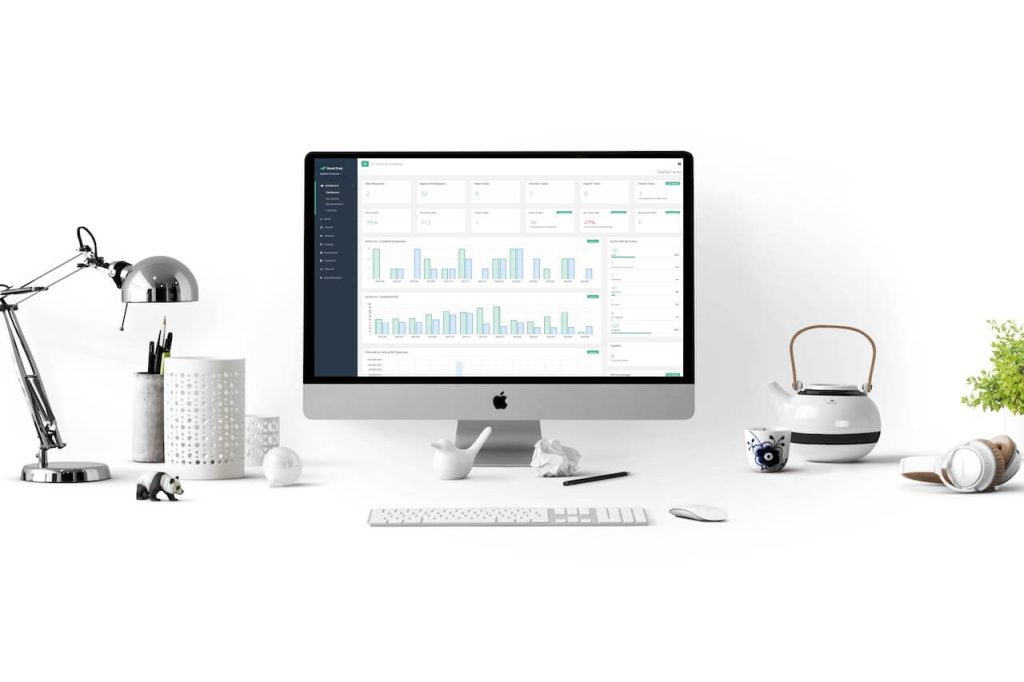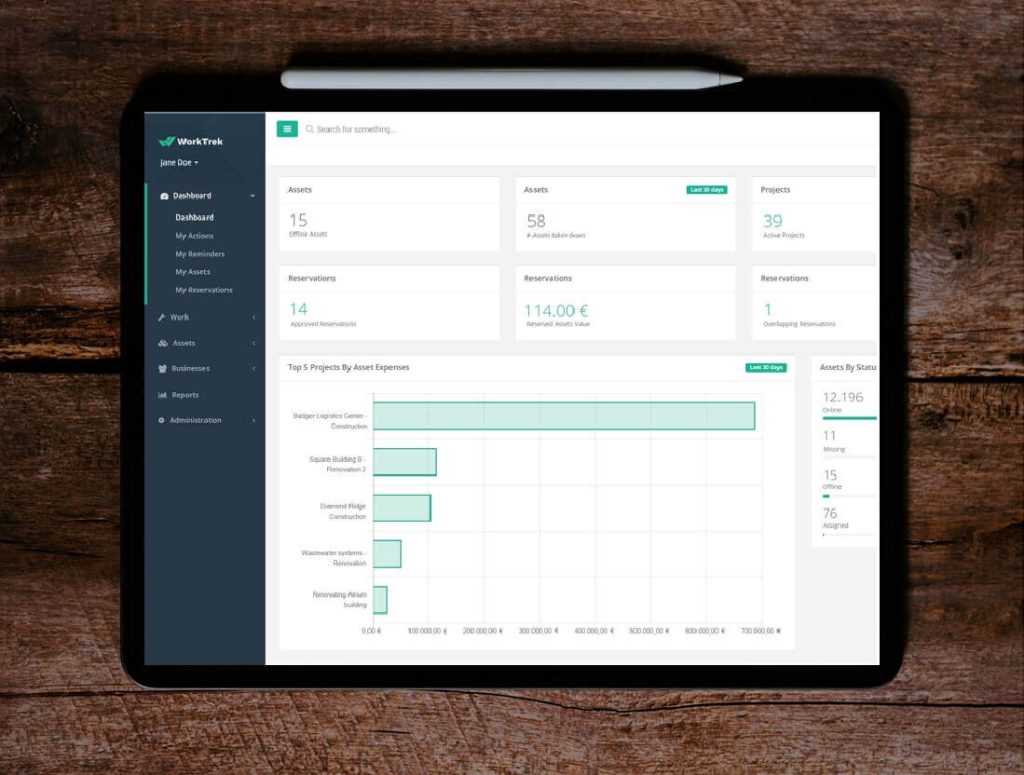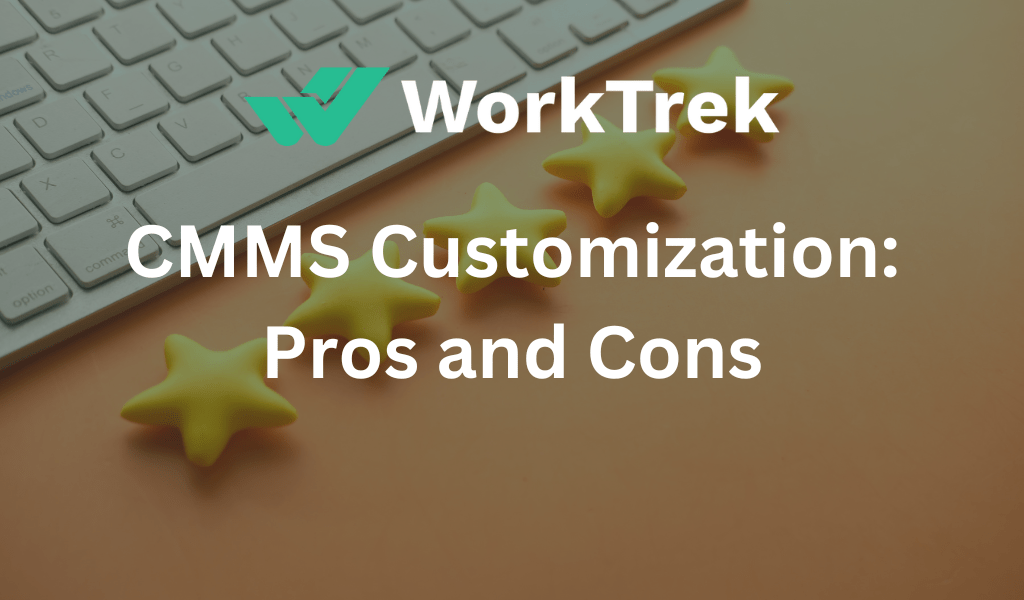Get a Free WorkTrek Demo
Let's show you how WorkTrek can help you optimize your maintenance operation.
Try for freeAfter years of helping you manage your office work, are you now finding your company’s custom CMMS software to be slow, and confusing, and your co-workers and colleagues feel that it’s not as effective as it used to be? Then it’s time to update, and this is where you can start.
Management software, order management software, warehouse management software, CMMS, etc. Whatever your needs, the professional world is full of software that helps us achieve results every day.
You might be surprised how many companies rely on software that was developed more than a decade ago or isn’t state-of-the-art on a day-to-day basis. It was slow, outdated, and had little in common with the newer versions, which made the tools increasingly user-friendly and intuitive for users. In fact, you’re probably reading this article because you’ve realized it’s time to make a change to your business.

What Is A CMMS?
The acronym CMMS stands for Computerized Maintenance Management System. This software package was designed to manage maintenance globally, on a strategic, financial, and operational level. It is today the essential software of the industrial sector. Much more than simple computer programming, it is an assistant for maintenance teams, the cornerstone of industrial efficiency.
Because you can use it to achieve different goals, there are different ways to describe computerized maintenance management software. On the one hand, it is sophisticated software that captures and uses thousands of data points to provide an overview of how a facility is an operating or detailed information about individual pieces of equipment. In terms of functionality, CMMS software offers businesses the ability to monitor inventory levels, manage work orders, set up and schedule preventive maintenance programs, and quickly generate accurate reports. But on another level, it’s just the solution maintenance managers need. Automating processes and streamlining workflows makes your life less stressful by making your workday more predictable.

How Does A CMMS Work?
The easiest way to understand how it works is to first look at two old ways of managing maintenance, paper and spreadsheets.
With paper, you always run the risk of losing or corrupting data. Every time you doodle a new work order, chances are you’ll include mistakes. And even if you copy everything perfectly, chances are someone will lose that piece of paper, your only copy of that essential data. With spreadsheets, it’s the opposite problem. The risks of copying and pasting bad data are still there, but now you often have too many copies of the same data. Why is this a problem? As soon as someone updates one copy’s information, all other disconnected copies are out of sync. In the end, each member of the team works from their own version of the truth. Everyone is out of it, but no one realizes it.

What Are The Main Benefits Of A CMMS?
The main benefits of CMMS software are:
Plan maintenance interventions
Using a CMMS, you can create maintenance plans and execute them individually for each piece of equipment. This gives you the opportunity to develop different types of interim interventions for each asset or group of assets with similar needs.
Immediate processing of work orders: Centralized systems can efficiently and often automatically create, prioritize, schedule, and manage work orders, reducing paper documentation and programming costs.
Reduce maintenance costs
A CMMS can help you track maintenance costs, track your investments, create reports to share, and save money when you need it.
Real-time asset information
Centralized cloud data is continuously collected and accessible to all, allowing all information about an asset to be retrieved with a single mouse click, simplifying problem identification and remediation.
Resource Monitoring and Control
To address issues related to material shortages or material overruns, a CMMS helps in monitoring and managing resource inventories and keeps track of stock items, special orders, or various itineraries.
Speedup inspections and repairs
By continuously monitoring resources, maintenance calls and inspections can be speeded up, reducing unplanned downtime; in fact, with a CMMS, you can read the history of problems and repairs to intervene as soon as possible.
Extending the useful life of assets
Resources that are continuously monitored and kept in an efficient state through inspections and planned ad hoc interventions will naturally extend their useful life.
Increased Safety
Damaged machinery poses a risk to the work environment and the operator. A CMMS reduces security risks by verifying that equipment is operating within certain safe zones and signaling appropriate intervention if necessary.
Improve system compliance
Managing security programs and controlling regulatory compliance is quick and easy. As a result, maintenance audits can be prepared in less time, with existing data in hand, saving time and money.
Improve work team efficiency
You can leverage the potential of a central platform to unify the activities of internal teams and coordinate them with external partners, improving workflow, improving communication between parties, and significantly reducing errors.

CMMS customized for your needs!
Book a WorkTrek demo to see how a CMMS can help your asset management.
Try for freeWhat Can A CMMS Implementation Help Your Maintenance Team Achieve?
By implementing a CMMS, your business can experience real change. However, it can only be successful if it understands its ultimate goal. This goal may vary from company to company, but we can identify some common goals that all maintenance companies want to achieve.
Meet and exceed your goals: Desired goals may include reducing downtime, reducing costs, or improving safety, among others. The right CMMS with the necessary features will help you achieve your goals, whatever they may be. However, success depends largely on clear goals and proper planning.
Standardization process: CMMS best practices unify all processes and procedures in one system. Having and using multiple systems can become confusing over time and create confusion when managing your business. CMMS implementations thrive and lead to positive standardization outcomes when integrated with other operational tools your business requires.
Force general users to accept: Maintenance management software can only have a real impact on the business when the right people use it consistently and correctly. User acceptance should be 100% to ensure efficient work, no missed tasks, and accurate data collection. Another thing you might want to consider is role-based access control to ensure that only users who need access can access specific data.
Driving digital transformation: A CMMS implementation is just the beginning of the digital transformation journey for your maintenance team. Successful adoption of maintenance management software can make an impact not just on the surface, but at the core. Automation moves the business forward and creates an environment for the maintenance department and beyond to grow.

What is Custom Software Development?
Any process of designing, developing, deploying, and maintaining software for a specific user, company, or organization is known as custom CMMS software development. Custom CMMS software development companies provide companies with software development tailored to their business needs. They are also responsible for consistent software upgrades, management, and quality assurance, with expert, scalable teams, careful project management, and tracking tools. Unlike commercial off-the-shelf software (COTS), custom software development is designed to facilitate specific tasks based on the needs of a business or company. It doesn’t follow a one-size-fits-all approach like COTS. Instead, it is used for data processing and problem-solving for large clients and companies.
Different Categories Of Custom Software Development
Depending on the needs of the company, custom CMMS software applications can be developed in three ways:
Fully custom CMMS software: This type of software is developed with the company’s needs in mind. The software was developed specifically for one company and only one company. A few examples of such custom software include software applications developed for Apple, McDonald’s, Google, etc.

Semi-custom Software
This type of software is chosen by companies that do not want to change all the software they are currently using. Instead, they urge developers to add minor changes and features to the software according to their needs. Some semi-customized software applications are data management platforms added to CRM, marketing automation platforms added to CMS, and even the company’s existing updated small business CRM, CMS, etc. It depends on how much the company wants to change the software it uses and centralizing client communication.
Duplicate Software
Most companies in the market require similar types of software applications to facilitate day-to-day administrative, logistical, and communication tasks. For such companies, little or no code changes are required to use the same software.
Where Do I Start Changing Software?
Switching software also has its downsides: you need to check for compatibility with other business systems, make sure it has all the features you need, works well, and that the vendor understands your needs. We know that none of this is obvious, and we often see the software in many companies that is not helpful to users. However, the effort is worth it because well-designed tools help save time, which means less stress, more money saved, and greater employee productivity.
Generally speaking, there are two ways: use off-the-shelf software or let a software company develop custom CMMS software. Both methods have pros and cons, so let’s take a look together.

What Are The Benefits Of Custom CMMS Software?
Unique software
When the software is customized, it is of course tailored to the needs of the company, and it is also unique. Creating custom programming articles for a company ensures that the product includes all the elements and functionality a club needs to run its business smoothly.
Programmers can create programs that fit the company’s goals and provide the company with ample opportunities for growth. Unique software can give your business an edge when it comes to maintenance.
Integration
Technology develops very fast. Team members as an organization may also need to extract data from other software to increase productivity. Custom software can leverage the data from the software to help the company get a better return on investment.
Integration is one of the most significant benefits of taking a custom approach. Integration comes in handy if the software needs to be redesigned in the future.
We know that there are a lot of upgrades that need to be regularly documented as part of maintenance, and with integration, it will be easier to create software later on.
Improve ROI
There is no doubt that investing in custom software is more expensive than traditional software. This is obvious because labor costs add up when you design software as you need it.
However, custom CMMS software is more productive than traditional software because it is tailored to the needs of the business and provides more detail than traditional software, which obviously increases the return on investment.
We know assets are expensive and keeping track of them is important, so a custom maintenance management tool can be of great benefit to a business.
Higher productivity
It’s a given: Getting the software that fits your needs translates into higher productivity and better operations. When productivity increases, it translates into better asset utilization, which means more production and more profit.
When you get accurate data information, you can manage assets more efficiently and effectively.

Disadvantages Of Custom CMMS Software
If you plan to move to a professional development team, carefully weigh the risks and consider the following disadvantages of custom CMMS software.
Long development time
Developing software from the ground up requires detailed planning and attracting world-class talent and resources. Therefore, the duration of development, including the discovery and testing phases, can take anywhere from a few months to over a year.
High upfront investment
The above solutions are quite expensive due to their complexity and high level of expertise. However, all costs are calculated in advance and predefined in the software requirements specification. This means there are no hidden costs, and the initial investment will pay for itself over time.
Support and maintenance
Exclusively tailored solutions require dedicated support services, such as live chat. However, you can rely on the expertise of a software development partner who truly understands your product.

Advantages Of Standard Software
Compatible price
Since packaged solutions are aimed at a broad audience, they are usually less expensive. Cost efficiencies are possible when multiple users “join” in support of the solution. Would it be cheaper than custom-developing my own software? Mostly yes:
- Some commercial software is offered as a monthly or annual subscription.
- There are often different plans available and differentiated by what is included.
- Sometimes, selected MVP tools even have free trial periods.
Ease of adoption and faster time to market
One of the greatest advantages of off-the-shelf software is its accessibility. In many cases, you buy a solution, access it, and make adjustments.
Many functions already exist. Additionally, many third-party solutions offer quick automatic installation or easy-to-use constructors with intuitive building blocks.
This can speed up time to market and MVP adoption, or integrate the functionality you need almost instantly. Does it help you get your work done faster? Certainly, especially when you compare custom CMMS software to off-the-shelf software in terms of development time frames.
Includes maintenance and support
You don’t have to worry about improving package solutions. All upgrades, optimizations, new feature releases, and maintenance are the responsibility of the Provider. You don’t have to constantly think about how to make the finished software better, safer, or more convenient. This is included in the package.
If you experience any shortcomings, you can contact the provider for assistance. If something goes wrong, there is usually a simple customer service program that can help you.

Disadvantages Of Standard Software
Let’s now look at the downsides of off-the-shelf software and the obstacles you might face if you decide to use it.
Lack of customization
Of course, each product can be modified to some degree, which requires additional resources. However, the end result is not always able to compete with solutions specially designed for a specific domain.
Redundant functions
Unfortunately, related products often have unrelated attributes. This complicates navigation and increases costs. You might agree that paying for extra features is the equivalent of buying a fancy car when all you need is a reliable family car. The reverse is also true, as the above solutions may not be enough to make your project a success.
Compatibility issues
Some technologies may become difficult to use because they may not be compatible with your current system. As a result, you may miss out on opportunities to take full advantage of technology-based innovations.

Final cost
The above-mentioned characteristics of the finished product lead to an increase in the final cost. Not only do they require ongoing investment, but they can also lead to financial losses due to a lack of uniqueness and competitive advantage.
Both types of software automation have many advantages and disadvantages. If your company is highly specialized and already has a core competency in software development, building your own CMMS may be a viable option. Before embarking on a project like this, make sure to conduct a thorough cost and benefit analysis. However, for most companies today, it’s best to buy an off-the-shelf CMMS.
Therefore, as a business owner, it is crucial to consider all potential factors and choose the software that suits your specific needs. You also need to consider how your decision will affect you in the long run.









